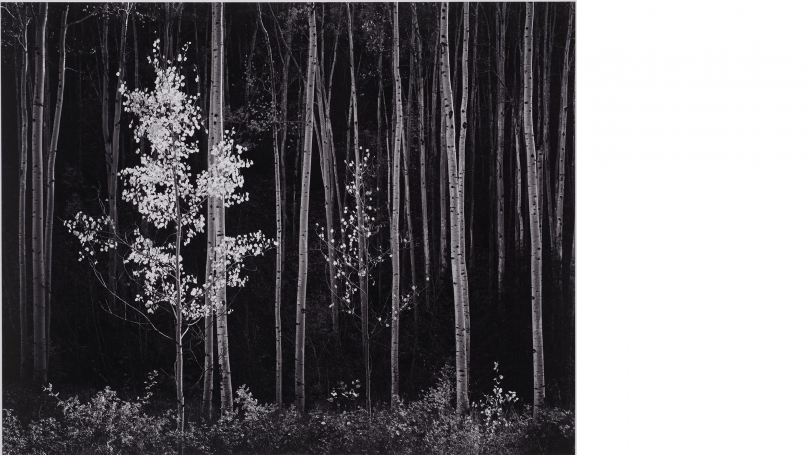Considered the preeminent 20th-century landscape photographer, Ansel Adams demonstrates his mastery in conveying the effects of light in a landscape in this iconic image of an aspen wood. The photograph was acquired in memory of Edward Hansen, a former member of the Board of the Hopkins Center and Hood Museum of Art, with funds donated in his honor by his friends and family, his wife, Julia, and his children, Victoria, Class of 1988, and Christopher, Class of 1985. When Hansen served on the Hop/Hood board in the 1980s, he was instrumental in raising funds for the new Hood Museum of Art building, which opened in 1985. He returned to the board in 2003, serving another four years. With Julia, he established the Hansen Family Fund in 1985, which supports the exhibitions program at the Hood Museum of Art.
Recalling the creation of Aspens, Northern New Mexico, 1958, Adams wrote: "I made this photograph on a crisp autumn day in the mountains north of Santa Fe; near the crest of the Sangre de Cristo Mountains, we came across a stand of young aspen trees in mellow gold. I immediately knew there were wonderful images to be made in the area. We were in the shadow of the mountains; the light was cool and quiet and no wind was stirring. The aspen trunks were slightly greenish and the leaves were a vibrant yellow. The forest floor was covered with a tangle of russet shrubs. It was very quiet and visually soft. The photograph is exceedingly popular at all levels of appreciation. I do not consider it a 'pretty' scene; for me it is cool and aloof and rather stately."
This new acquisition is also a superb example of Adams's involved and masterly printing technique. The photographer considered what happened in the darkroom to be as important as the capture of the image itself. He is known for the beauty of his prints almost as much as for the magnificence of the landscapes he recorded with his camera. The manipulation of the negative during printing was Adams's way of trying to capture the sense of what he experienced when he was taking the picture. There is an expansive tonal range and level of detail in his photographs that lend his work a sense of grandeur and stillness. The Adams photograph acquired by the museum embodies this enduring aesthetic and will be used in photography courses in studio art and art history and also by environmental studies courses that engage in writing and discussing photography and its relation to the landscape and environmental issues.
